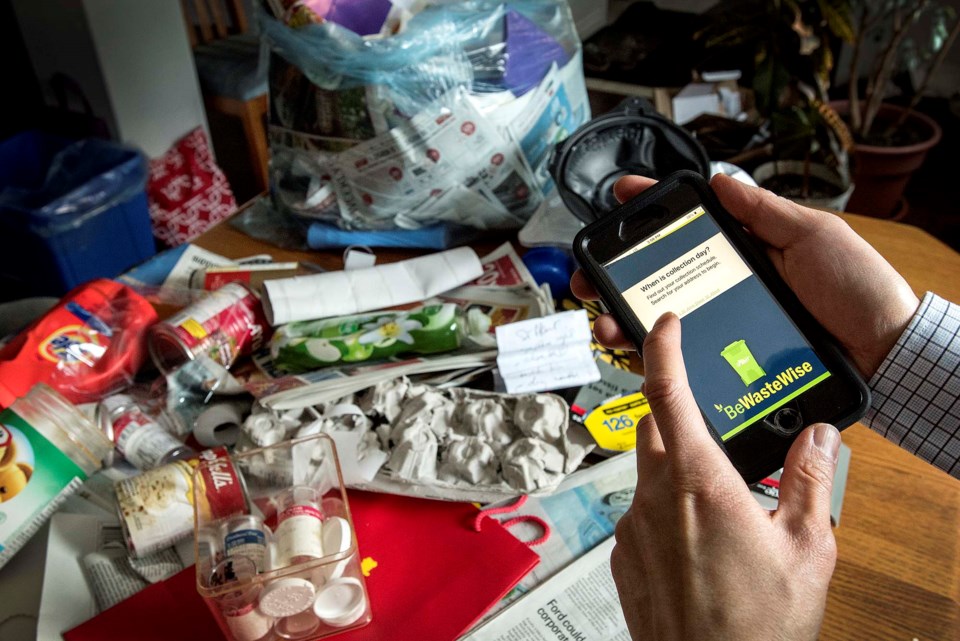St. Albert still isn’t meeting its greenhouse-gas and trash-reduction targets, says a recent report, but new grants and a trash audit could help the city get back on track.
The City of St. Albert released the 2021 Environment Report Card online May 19. The report tracks the city’s progress on nine goals set in its 2014 environmental master plan.
Typically published on Earth Day (April 22), this year’s report was delayed due to the pandemic and data delays, said City environment manager Meghan Myers. (Last year’s air pollution data was not available, for example, so the report’s air quality update was based on 2020 data.)
Good grades for trees
The City fell behind on its tree planting efforts in recent years after it suspended many public tree-planting events and its tree-replacement program during the pandemic. The report shows some 1,940 trees planted last year, compared to 5,000 in 2019. St. Albert aims to expand its tree canopy to cover 20 per cent of its land with trees by 2037 — it currently sits at about 13-per-cent tree cover.
The City’s tree-replacement program is back on as of this year, but will need about three years to catch up, said St. Albert senior public works manager Louise Stewart.
The City continued to meet its density targets for subdivisions and continued to fall short on transit, the report found. Just 252,274 people commuted by bus last year, continuing a decade-long decline in ridership exacerbated by the pandemic. (Some 1.05 million people took the bus in 2011.)
Myers said much of the recent decline in ridership was due to the pandemic. The pandemic might indirectly help meet transit’s true goal of reducing transportation-related pollution, though, should it encourage more people to work from home.
The Sturgeon River Watershed Alliance continued its work to roll out riparian health and water-quality monitoring programs, the report found. Overall water quality was stable, with pesticide use remaining far below target levels.
The City’s environmental stewardship efforts also got back on track last year with the resumption of the Environmental Initiatives grants, public tree plantings, and the Clean and Green Riverfest.
Stumbles on carbon, trash, water
St. Albert’s corporate greenhouse-gas emissions climbed four per cent last year and are now slightly above target levels. The report noted how the 1.1 MW solar array the City installed last year at Servus Place is trimming about 580 tonnes of emissions off the city’s carbon footprint each year.
Community emissions also resumed their upward trend, rising 0.2 per cent after a slight decline in 2020. The city is now three-per-cent above 2008 levels in terms of greenhouse-gas emissions — a long way from its target of six per cent below 2008 levels, and light-years from the net-zero levels climate scientists agree must be met to prevent global heating.
Myers acknowledged that the City’s greenhouse-gas targets were out of date, but said net-zero goals weren’t really on the table for cities back when the environmental master plan was passed in 2014. The City had applied for a grant from the Municipal Climate Change Action Centre this year to update its emission targets.
“The majority of our community emissions (60 per cent) come from transportation and residential buildings,” Myers said, and that is where the city needs to make the most progress.
Up until now, the City has focused on low-cost emission reductions such as its idle-free bylaw and the free home energy audit kits available at the public library, Myers said. The Clean Energy Improvement Program and Home Energy Retrofit Accelerator grants are both set to roll out this fall and should address building-related emissions, especially when combined with new Canada Greener Homes grants. The City has also applied for grants to install four electric-car charge points later this year, which should encourage more zero-emission vehicles to hit the road.
The city’s waste diversion rate continued to plummet last year, down to 46 per cent from 58 per cent in 2020 and far below the City’s target of 75 per cent. St. Albert sent 10,565 tonnes of junk to the dump last year, the mass equivalent of about 813 St. Albert Transit electric buses.
Most of this increase was due to people working from home during the pandemic and companies backtracking on single-use item reduction plans, said City waste management manager John Potter. City crews will do a trash audit this year to figure out where to focus waste-reduction efforts and will have a revised single-use item reduction strategy before council early next year.
Per-capita water use in St. Albert rose about six per cent last year to 228 L/person/day, likely due to hot conditions, the report showed. The city is now 28 litres above its water-use goal of 200L/person/day. Myers said the City will revise its water conservation bylaw this year to try and reduce water use.
The report is available at stalbert.ca/city/environment/reports/report-on-the-environment.




